A nature inspired garden, making compost and coping with ground elder
This week I’m writing about a wonderful garden nestled by a river in the Brecon Beacons in Wales. If I mention its a RHS Partner garden, you will probably guess the name of the garden .....
🌱 I'm Sally Morgan, an organic gardener and botanist based in the west of England who loves to experiment. Here you can read about matters relating to climate change, sustainability, organic gardening, growing veg and biodiversity, helping you to become a
climate savvy gardener 🌱☀️🌧️❄️🌡️
Happy Easter
This week I’m focussing on a wonderful nature inspired garden in the Brecon Beacons in Wales – Nant-y-bedd, owned by Sue and Ian Mabberley
Nant-y-bedd is a garden I’ve wanted to visit for along time. I’ve had ‘virtual conversations’ with Sue for a while, but we’ve never actually met in person until this week. Sue had suggested my name to the local Llanthony garden club and this week I drove to Wales to give a talk on climate change in the garden. I was delighted to have an audience of more than 50, which was remarkable given the talks take place in a remote village hall, north of Abergavenny. The club is thriving and if you live in the area, or are holidaying, please check out their talks programme.
The next day, my travel companion Linda and I made our way to Nant-y-Bedd which translates as ‘Stream of the Grave’ after the two Bronze Age burial mounds from where the stream running through the garden starts its journey.
Linda loves writing, so I invited her to contribute to this week’s post:
Just returned from the back of beyond...the pretty back country of Wales, beyond easy interference by the modern world.
Nant-y-Bedd gardens are not easy to find, we ignored SatNav and, instead, relied on Ian's quirky, but wholly accurate, directions from their website. It was an...interesting...drive along some of Wales' single-track lanes. Storm Darragh (Dec 24) had brought down large numbers of trees which had been cleared to allow passage, but left huge trunks that were rather unnerving to come across round a bend, the cross sections pointed directly at us, precariously held back by vegetation and seemingly poised to shoot down the hill directly at us with the least provocation.
Sue and Ian own and enjoy Nant-y-Bedd and were hospitality personified; their warm personalities reflected in the gardens they have nurtured for 40-odd years. From the way they talked about how the land has changed over the time, and how they had worked on it, I could see they hadn’t designed or changed the land, so much as worked with the land. There are wild areas and more cultivated areas, but even these are not regimented. I listened with great pleasure to Sue as she talked about the history of the gardens and knowledgably about the plants. Ian was there too and was much as I had imagined him from his writing style on the website, friendly with gentle humour.
There are playful features, like a sculpture where a tree had once stood, but without trace of a stump. When the tree came down, the bottom couple of metres of trunk and roots had been left in place. Local landscape sculptor, Mick Petts, had sculpted it in place, shaping it so that fern fronds appear to emerge naturally from the trunk. There was the fun of a rope bridge to cross, but I was especially excited to see a sturdy tree house. I have wanted to go into a proper tree house ever since I was small fry, so I finally managed it; with a lot of effort but I did it!
Everything about Nant-y-Bedd brought a smile to my face, well …perhaps the hilly terrain involved a fair bit of puffing… whether from fun features and tranquillity of the bathing pond and shepherd’s hut to joy amongst the trees listening to the birds. I would love, love, love to go back again sometime to experience it in different seasons and over time to learn how it develops and grows and of course talk again with Sue and Ian.
Thank you Linda - you have captured the spirit of the garden far better than I ever could.
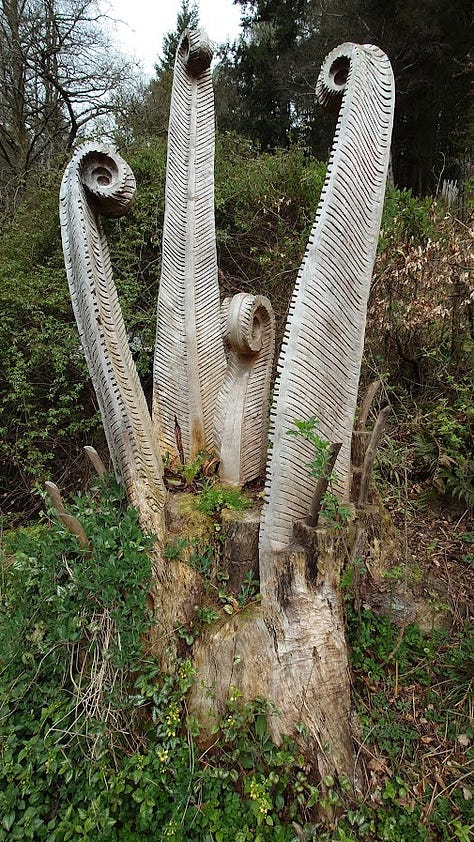
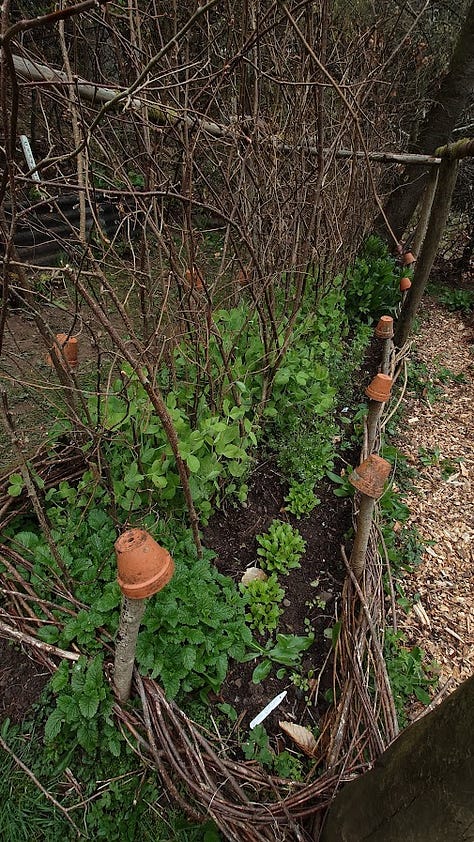
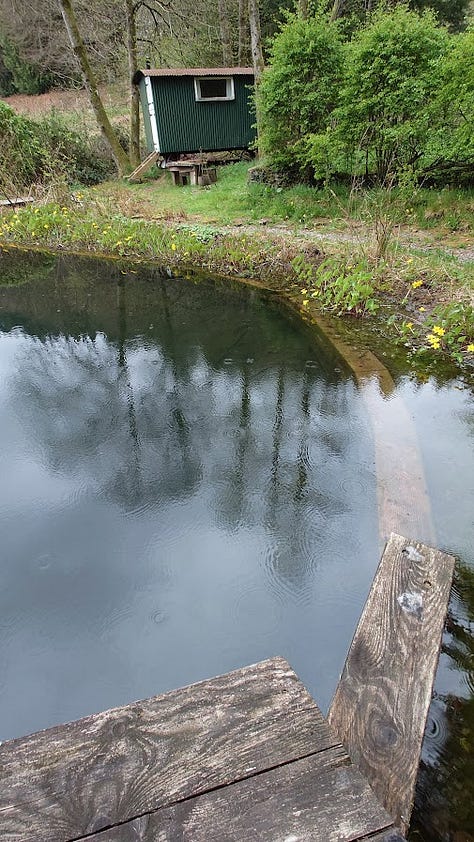
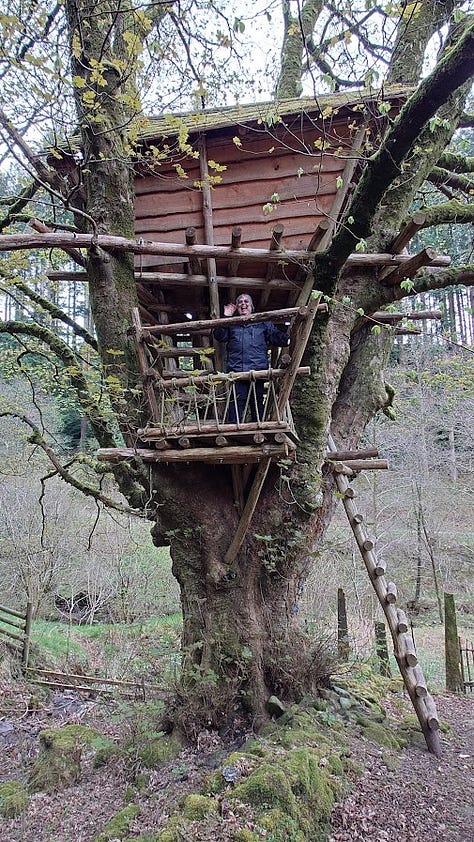

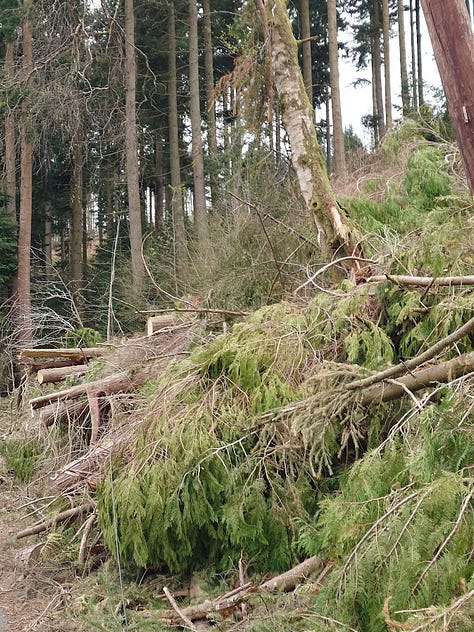
The garden lies about 30 mins north of Abergavenny and is open Wednesday, Thursday, and Friday from June 4th until August 29th - check out the website for more details as booking is essential. RHS and Garden Organic members can use their cards and get 2 for 1 tickets. There are also workshops.
It is so worth a visit. You can also book a tour with Sue, which Linda and I both recommend. The garden hosts a number of workshops through the year, from managing a wild garden, garden sculptures, foraging and writing. There is a list on the website.
So from me a couple of practical take away ideas….
Composting
Sue takes great pride in her composting system - I think its fair to say she is absolutely passionate about it.
The compost bins are built from wood with sturdy posts and sides of timber, lined with wriggly tin to protect the wood, extend their life, and add an element of insulation. Each compost bin is filled in turn, in one go, so Sue collects and stores materials ready for use. There is always a good mix of brown (woody material, partial composted wood chips) and green (weedings, vegetable kitchen waste, grass clippings, young nettle shoots etc), along with animal manure and bedding.
The larger pieces of material are either shredded or cut into shorter lengths with shears before being added in alternating layers of green and brown. Water is essential to composting so the layers are watered and then the finished pile is covered with a thick insulating layer. Sue makes use of her sheep fleece which is sealed in black plastic bags, duvet-style. This keeps the water out and the heat in [I am going to steal this idea as I have a lot of fleece!].
The insulating layer is important to keep the temperature within the pile at 45-60C which is sufficient to kill weed seeds and pathogens. If its not hot enough, the material is given a stir to incorporate more oxygen and give the microbes a boost.
Sue finds that her compost takes around 3 months to break down to a state that she can use it as a mulch and is left longer for more complete breakdown.
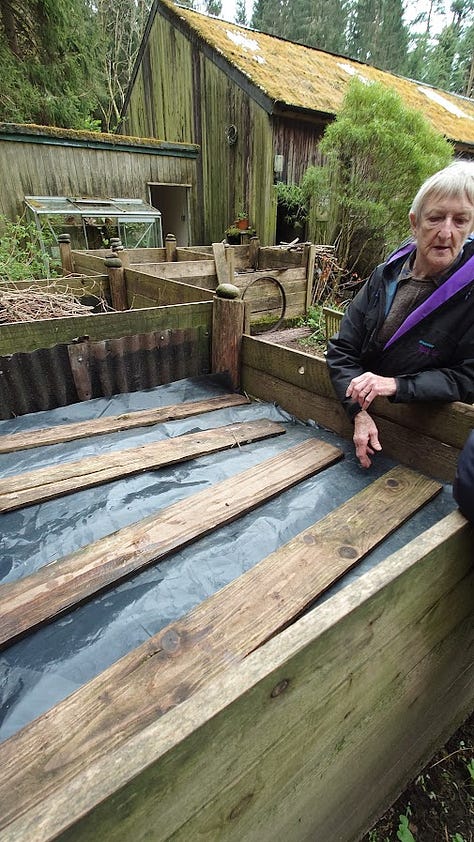
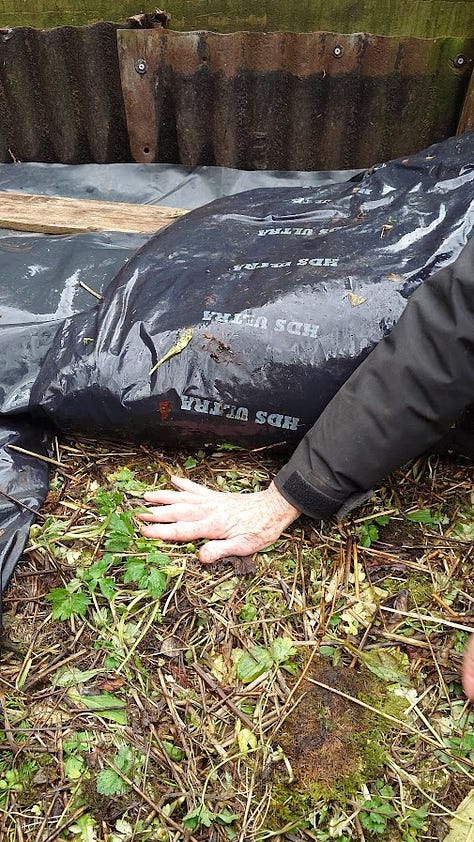
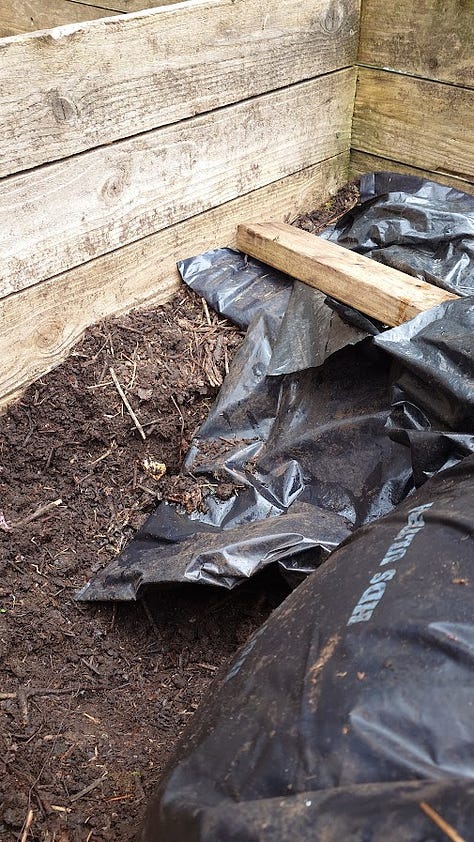
If you want to learn more, watch this video on the Nant-y-bedd website
Controlling ground elder (Aegopodium podagraria)
Ground elder is bane of many a gardener. First introduced to the UK as a food plant by the Romans, it soon spread and naturalised. It has quite a tasty leaf, a bit like a sweet parsley, and the tender young leaves are great in salads. The older leaves are still edible but need cooking like spinach. To keep the plant in check, chop the leaves regularly.
Sue has more than enough ground elder in parts of her garden and has stumbled across a method of control. She showed me a bed with ground elder around the plants on one side and the loosestrife Lysimachia ciliata ‘Firecracker’ on the other. This loosestrife is a tall plant that reaches around one metre in height and has wonderful purple leaves and yellow flowers. It prefers a rich soil that doesn’t dry out, so it’s often found in wet meadows and near ponds.
Have a good look at the photo above. On the right you can see the purple leaves of ‘Firecracker’ but there is very little ground elder. On the left side there is a lot of ground elder.
One of the best approaches to ground elder is not necessarily to dig it out but to give it competition in the form of a ‘thug’. In this example, the balance is working out in the loosestrife’s favour. The alliums and tulips seem unaffected by the competitive nature of either. There are other plants that are considered tough enough to compete with ground elder – they include bugle (Ajuga reptans), dead nettles (Lamium sp), ferns, especially Dryopteris, and Vinca minor.
I did wonder if Lysimachia had allelopathic traits - producing chemicals from the roots that inhibit the growth of other plants. I can’t find any reference to this specific species, but yellow loosestrife does, so may be this is having a role here…
Happy gardening
PS If you enjoyed reading this post, please click the ‘like’ button at the bottom, it really helps make my posts more visible on the SubStack app. Thank you xxx
Talks in 2025
28 April Thurloxton Garden Club
2 May Gardener’s World Spring Festival at Beaulieu, I’m on ‘In Conversation with stage’ at 2.30. Do come and say hello if you are visiting the show
3 May Hotwells & District Allotments Association, Bristol
27 May East Mendip Garden Club at Oakhill
28 May Thruxton Garden Club
5 June Teignmouth Garden Club
10 June Frome Selwood Horticultural Club
1 July Sherston, near Malmesbury
9 July Bramzero, Calne
21 July Bride Valley near Dorchester
1 September Wootton Bassett
2 September Marshfield
4 September Dilton
18-20 September Yeo Valley Garden Festival
1 October Henleaze, Bristol
2 October Ringwood
9 October Seavington
10 October Box near Corsham
11-12 October Bury St Edmunds Literary Festival
13 October Rode, near Frome






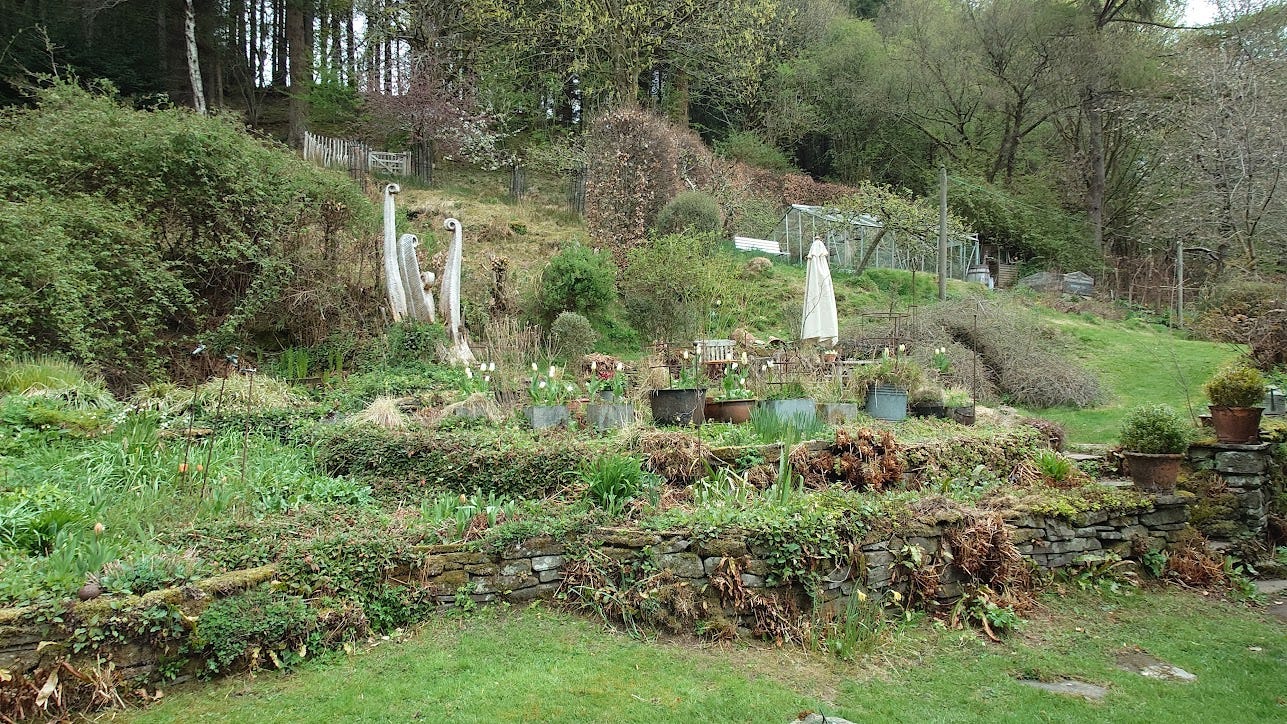



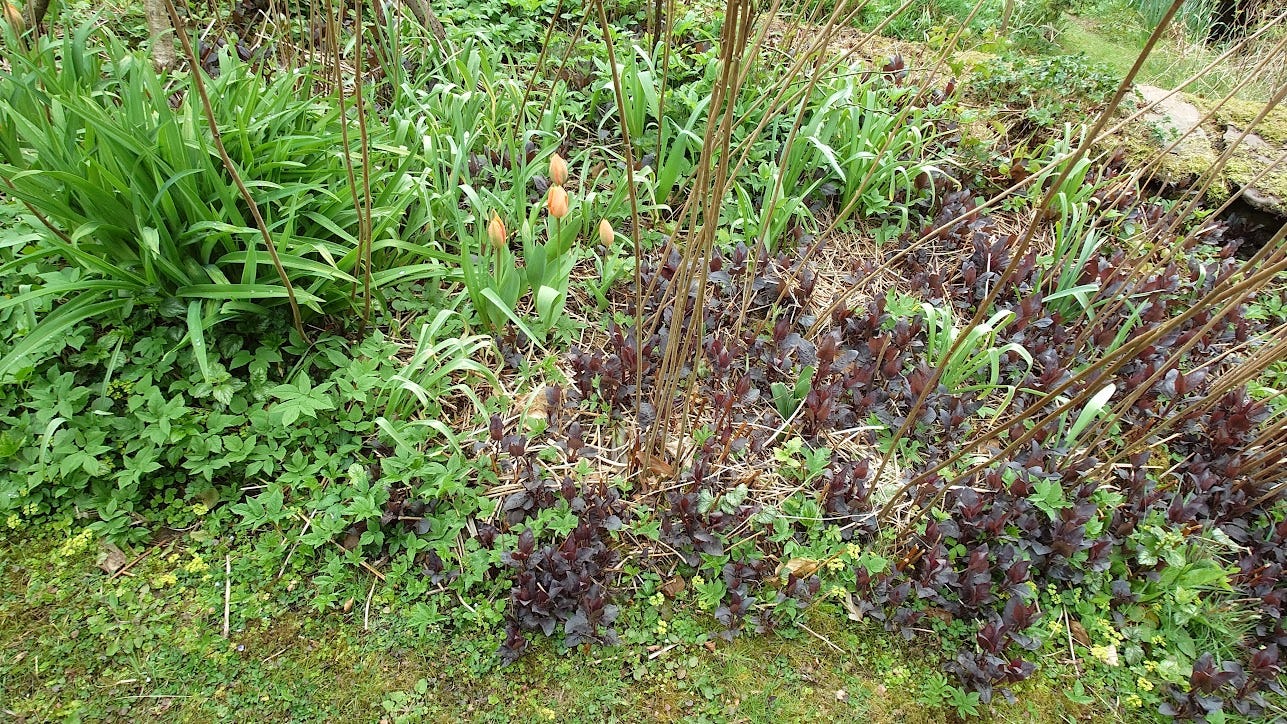

That's such an interesting tip about ground elder! Thanks Sally :-)
Loved reading this. Makes me want to go to Wales and plan a visit in this garden. But I can't imagine renting a car and driving on the left side of the road! Is there public transport or taxis in this area, that would make a visit possible?